

UNLIMITED AIR RACING - RENO 2019
Text and Photos by Dan Whitney
Published 09 Feb 2020
High-Resolution Images in the Members Section
Unlimited class air racing at the Annual STIHL National Championship Air Races completed its 56th continuous year, since being reintroduced in 1964. This annual event is held at Reno’s Stead Field, a site uniquely configured to host the World’s Fastest Motor Sport, with its two long runways within the course, in an open desert arena ringed by adjacent mountains that gives spectators an unobstructed view of the entire course. The races were held September 11th thru the 15th , and included seven classes of racing: Biplanes, Formula One, T-6s, Sport, Jets and Unlimiteds, as well as the introduction of a new class this year, which is STOL Drag Racing! Added attractions included some outstanding airshow performers filling in between races as well as demonstrations by the Commemorative Air Force, and the awesome USAF Thunderbirds.
All together there were 60 races in four and a half days of racing, with 115 air racers on the field. For a week, “Reno” is a busy place with a lot of excitement and action: just what you would expect of the World’s Fastest Motor Sport!
The Unlimited Division, WWII and Korean War warbirds comprised 12 racers, down a few from last year, but still more than the 11 racers in 2016. The racers were organized into “Silver” and “Gold” competitors, as determined by qualifying speeds, with the winner of the Silver Heats moving up to the Gold division. As a result there were two Unlimited races each day, Thursday through Sunday. The weather was again perfect for air racing, lots of sunshine, moderate winds, and no smoke from the California wildfires.
The emphasis on safety again paid off, with the only major incident being when two of the Formula One class racers had a mid-air, but fortunately both were able to land safely.
Unlimited Overview
 |
| R-4360 powered Sea Fury Dreadnought coming by pylon 2 in the Sunday Unlimited Gold Final. Piloted by Dennis Sanders, #8 finished with a speed of 403.274 mph, while lapping the rest of the field, a consequence of his major competitors having to pull out for mechanical reasons. |
This year’s Unlimited field included seven P-51 Mustangs, four Sea Furys, and an Allison V-1710 powered P-63A. There were two highly modified racers, Dennis Sanders Dreadnought, the R-4360 powered Sea Fury and Dr. Brent Hisey’s P-51D Miss America fitted with a special racing Merlin. One racer that had done a lot of preparation for this year’s competition is the Sea Fury Sawbones. Unfortunately, while practicing for its qualifying run, the airplane suffered an implosion of the canopy, rendering the racer unairworthy for the week. Fortunately, pilot Curt Brown was uninjured, the result of having a proper helmet and visor.
Please see the table at the end of this article for a complete listing of the racers, the airplane’s name, the names of the pilots, along with the speeds and finishing positions for qualifying and in each heat.
The Unlimited Races
With the exception of the Sunday Silver and Gold races, the races were of six laps duration, for a length of 46.99 miles. For Sunday’s finals, the Silver was seven laps, 54.90 miles, and the Unlimited Gold race was for eight laps, 62.81 miles.
All racers have to be on the field the Saturday before race week. Qualifying began on Monday and extended to noon Wednesday. That afternoon the airshow and non-Unlimited classes began racing, with the first Unlimited race occurring Thursday morning.
Thursday – Traditionally the four fastest Gold Class Unlimited racers get the day off; this meant that Dreadnought, Miss America, Argonaut and #924G could stay in the pits and continue preparations for the hard running to come. This left seven racers to compete in the Silver heat, a race that was dominated by Mike Brown in his highly polished P-51D Mustang Goldfinger, who won by 45 seconds, with a speed of 335.864 mph. He was followed by group of five more Mustangs who all finished within a span of five seconds, the fastest being Dan Vance in Speedball Alice at 308.407 mph! In last place was the P-63C Pretty Polly, more than a minute behind with a speed of 276.207 mph. |
Friday – The Unlimited Silver heat was an all “In-Line” engine race with five Merlin-powered Mustangs and the single Allison-powered P-63C, Pretty Polly. There was some very good racing between Mustangs Speedball Allice, Blondie and Wee Willy II. They finished with a span of less than two seconds after nearly 47 miles of racing, posting speeds of 315.562, 314.701 and 314.469 mph respectively. They were followed by Mustangs Lady B, 300.419 mph, and Bunny, 296.638 mph, and Pat Nightingale in the P-63C at 293.177 mph. Pat Nightingale and “JD” Dale were trading piloting duties in the P-63. Finally on Friday we got to see all of the “Gold” Unlimiteds racing for the first time. The race was won by Dennis Sanders in the Sea Fury Dreadnought, 420.785 mph, and followed by some 38 seconds, the P-51D Miss America at 384.368 mph. They in turn were followed by the Sanders Sea Fury stablemates Argonaut (R-2800 powered) and 924G (Bristol Centaurus powered), with speeds of 365.730 and 364.348 mph respectively. Bringing up the rear, in 5th place, was Mike Brown in his P-51D Mustang Goldfinger, 325.593 mph. Clearly, no one was pushing their “stuff,” particularly Miss America who had had engine problems on Wednesday and nearly pulled the engine. |
Saturday – The Silver heat was to again be an all “in-line, liquid-cooled” event of five racers, however when it became time to start-up Pretty Polly’s electric starter would not engage, with the result that the P-63C was a DNS —— Did Not Start. This left four Merlin-powered Mustangs, Blondie, Wee Willy II, Lady B and Bunny. They started in this order, the consequence of having finished Friday’s heat in this order, and again finished as they had started. Their speeds were much better than on Friday, finishing with speeds of 321.644, 318.368, 316.439 and 315.101 mph respectively. Actually some pretty close racing as the stock airplanes were very well matched and it came down to piloting to get position. Unsurprisingly, Dennis Sanders in Dreadnought won the afternoon’s Gold heat with a speed of 418.770 mph, bettering his qualifying speed of 417.868 mph. He was followed by Brent Hisey in P-51D Miss America, 395.765 mph, who stayed ahead of the two Sea Furys Argonaut, 363.554 mph and 924G, 360.415 mph. They were followed by Mustangs Goldfinger, 334.863 mph, and Speedball Alice at 397.478 mph. Not too exciting of a race, but then, everyone wanted to be in the show for Sunday’s Gold. |
Sunday – The week’s good luck on weather continued into Sunday, bringing out the crowds and raising the excitement as each racing class was “going for the gold!” The day’s first Unlimited heat was for the Silver, and included the same four Mustangs from Saturday’s race, though they were joined by Pat Nightingale in the P-63C Pretty Polly. Although from start to finish the order didn’t change, there was some serious challenging going on up front, with Wee Willy II only 0.3 second behind Blondie at the finish of the seven lap 54.9 mile race, posting speeds of 330.056 and 330.231 mph respectively. For the four Silver races, beginning Thursday, Blondie posted speeds of 306.857, 314.701, 321.344 and 330.231 mph, showing improvement each day. The last race of the week is the Unlimited Gold Final, an eight lap race extending for 62.81 miles. The field only contained six racers, but the crowd was anticipating some heated action between the R-4360 powered Dreadnought and the racing Merlin-powered P-51D racer Miss America. Though the weather appeared good, there were wind gusts that made for some rough rides for the pilots late in the afternoon. Soon after the start Sherm Smoot in Argonaut hit some turbulence and lost his ADI (Water Injection), hence he Mayday’d out, leaving five on the course. As expected Dreadnought and Miss America were hard at it when on lap 3 the Merlin in Miss America began to go away and Brent Hisey pulled out and made a safe landing. With only the Centaurus powered 924G and two stock Mustangs following Dennis Sanders throttled back to save Dreadnought’s R-4360 for another day/year. The other racers also backed off; with the result that Dreadnought lapped the field, passing 924G just before the checkered flag and having already passed Goldfinger and Speedball Alice. Dreadnought completed the eight laps, followed by 924G with seven laps, Goldfinger with six laps and Speedball Alice five laps. Although the final speeds were not over 500 mph as has occurred in prior years, with Dennis passing everyone there was a lot of action on the course and it was a fun feature event to see. |
The Racers
The following descriptions of each airplane are given in the order in which they qualified. See the table at the end of this article for speeds and placement in all of the Unlimited Heats.
#8 Dreadnought, a Sea Fury T.Mk.20, re-powered by a Pratt & Whitney R-4360, and piloted by Dennis Sanders. This big and heavy airplane takes the approach to racing of being pretty, and very dependable: likely to finish in the money when one or more of the highly modified racers has problem, which was the case this year as the likely competition was to be from Miss America and Sawbones. Back in 1986 Dreadnought set a new qualifying record at 452.737 mph, but this year qualified at a very conservative 417.868 mph. Prior to its first qualifying attempt on Tuesday, it was found that the ADI water regulator was not functioning. To insure it was “in the show,” Dennis took the big racer out and posted a speed of 381.009 mph, running without ADI/Water Injection. Pete Law then stepped in and installed a spare water regulator and that afternoon Dennis was the last one to qualify, this time with ADI and upped his qualifying speed to 417.868 mph. This year Dreadnought ran 403 to 420 in the Gold Heats and was in front at the finish on Sunday with a speed of 403.274 mph, and was more than a lap ahead of second place. The original concept for Dreadnought was to have a really big engine and not have to run it to dangerous levels, thereby being able to be there at the finish. It sure worked this time.
#11 Miss America, a clipped wing P-51D flown by Dr. Brent Hisey, was back at Reno powered by a Rick Shanholtzer racing Merlin. This engine uses the supercharger section from a Packard-Merlin V-1650-9, transport cylinder heads, Merlin rods and makes 110 inHgA at 3,600 rpm utilizing the stock Merlin aftercooler. A potent race engine!
Brent qualified at 414.131 mph, while running the engine at 100 inHgA and 3,400 rpm. This locked him into the Gold Heats for the week, where he finished in second place in both the Friday and Saturday heats. Saving the “good” stuff for Sunday’s Gold!
After Tuesday’s qualifying run the crew found metal in the engine’s oil screens and elected to replace the race engine with a stock Merlin. During preparations for removing the engine the cam covers were pulled and it was found that one of the hardened pads on the cam rocker fingers had been lost. This was determined to be the source of the offending metal. The decision then was to not remove the engine, but flush it well, replace the rocker, and get back to racing!
This approach did let them race for the rest of the week, however on the 3rd lap, with the engine at 115 inHgA, in the Sunday Gold Final a piston was burned, a piece came though the cylinder bank and a small fire occurred under the cowling. Brent quickly pulled out and landed safely. Rumors are that some significant airframe changes are coming for next year!
#114 Argonaut, a Pratt & Whitney R-2800-CB3 powered single seat Sea Fury FB Mk.11 was flown again by Sherm Smoot, qualifying at 372.497 mph and earning a “Bye” from racing on Thursday. Sherm finished in 3rd place during both the Friday and Saturday Gold races. While on the first lap of the Sunday Gold Final there was considerable gusty wind and turbulence out on the course, with the result that the ADI was lost. With no time to troubleshoot the issue Sherm elected to Mayday and drop out of the race. It was then determined that his elbow had inadvertently hit the ADI switch!
#924G is a two-seat Sea Fury T.Mk.20, powered by a rare Bristol Centaurus 18-cylinder sleeve valve engine. This year it was flown by Joel Swager, who qualified the racer at 372.341 mph. This speed put him 4th on the qualifying list and resulted in a “Bye” from racing on Thursday. During the Friday and Saturday Gold heats he finished 4th as well, placing him in the 4th position for the start of the Sunday Gold. As a result of Miss America and Argonaut both dropping out of the final Joel finished 2nd, though lapped by Dreadnought during lap seven of the scheduled eight laps.
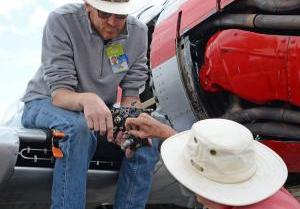 |
 |
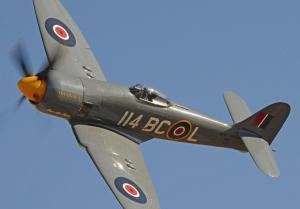 |
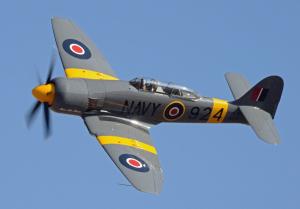 |
| AEHS Member Pete Law (White Hat) showing hookup details on Dreadnought’s replacement water regulator to team member Joel Swager. Joel piloted Dreadnought to the Unlimited Gold win in 2018 and this year piloted the Sanders Team’s Centaurus-powered Sea Fury #924G to second place in the final. This year Dreadnought was piloted by Dennis Sanders. | Miss America after the Gold Final on Sunday, the effects of the oil fire under the cowling are clearly shown, fortunately no major damage was done. | Argonaut flown by Sherm Smoot during the Saturday Gold Heat in which he finished in third place with a speed of 362.554 mph. On the first lap in the Sunday Gold Final the ADI was inadvertently turned off and the P&W R-2800 powered racer elected to come in and land. | #924G is a rare Centaurus-powered Sea Fury TMK 20. This photo was taken during the Friday Gold heat where pilot Joel Swager finished 4th with a speed of 364.348 mph, just behind stablemate Argonaut at 365.730 mph. These are two well matched racers. |
#2 Goldfinger is a stock Rolls-Royce Merlin-powered P-51D owned and piloted by Michael Brown. He qualified Goldfinger at 353.864 mph and won the Thursday Silver Heat at 335.864 mph, qualifying him to move into the Gold field for the rest of the week. There he finished 5th during the Friday and Saturday heats, and with the attrition in the Sunday Gold Final, made the podium with a 3rd place finish of 300.640 mph.
#31 Speedball Alice is a stock Merlin-powered P-51D qualified and raced by Dan Vance. His qualifying speed was 348.012 mph, 30 mph faster than his 2017 qualifying speed. Starting in the Thursday Silver heat, he came in second at 308.407 mph, and then won the Friday Silver heat with a speed of 315.562 mph, which allowed him to bump up into the Gold races for Saturday and Sunday. There he finished in last place each day, clearly not pushing the airplane to the point that he completed only five of the eight laps and was lapped three times by Dreadnought in the Final, their speeds being 239.332 versus 403.274 mph.
#44 Sparky/Blondie is stock Rolls-Royce Merlin-powered P-51D, and flown by Brant Seghetti. Brant has been flying the aircraft at Reno since 1997, and qualified his racer this year at 342.772 mph. Brant finished 3rd, behind Speedball Alice in the Thursday Silver race, and then 2nd on Friday. With the bumping of the racers ahead of him into the Gold class, he finished 1st in the Saturday and Sunday Silver heats with speeds of 321.344 and 330.231 mph respectively.
#0 Wee Willy II, a stock P-51D flown by Robbie Patterson, qualified at 322.886 mph. In the Thursday Bronze Heat Wee Willy II came in 4th with a speed of 306.469 mph, then on Friday finishing 3rd and on Saturday 2nd in the Silver heats. In the Sunday Silver final Wee Willy II was again 2nd, nearly catching Blondie for the win, while marking a week in which every day was a faster speed.
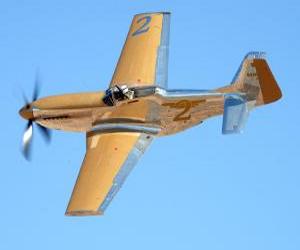 |
 |
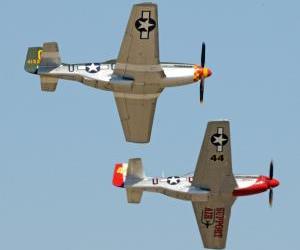 |
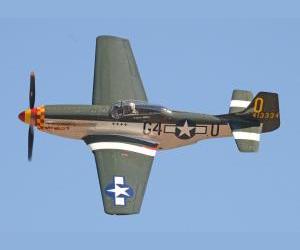 |
| #2 Goldfinger, a clipped wing P-51D piloted by owner Mike Brown, qualified at 353.661 mph in Thursday’s Silver heat, bumping his way into the Gold class for the rest of the week and earning third place on the Podium for Sunday’s Final Unlimited race. The highly polished racer reflects the desert landscape below. | #31 Speedball Alice is a stock Merlin-powered P-51D and piloted by Dan Vance, shown here during Friday’s Silver heat, which he won with a speed of 315.562 mph. This bumped him into the Gold for the rest of the week. | Stock-Merlin powered P-51Ds #44 Sparky/Blondie and #0 Wee Willy II battling it out during Friday’s Silver heat. #44 Sparky ultimately won, finishing in second place at 314.701 mph with #0 Wee Willy II at 314.469 mph, crossing the finish line only 0.397 seconds apart. | #0 Wee Willy II is a stock P-51D Mustang piloted by Robbie Patterson. He qualified at 322.886 mph and finished the week in the Sunday Silver race in second place with a speed of 330.056 mph. |
#63 Pretty Polly, was the forth Bell P-63A Kingcobra built and after spending the war doing test work for the NACA was surplused. The Palm Springs Air Museum restored the aircraft as a P-63C and it was flown alternately by Jim “JD” Dale and Pat Nightingale. Originally the aircraft had a two-stage Allison V-1710-93 engine; however the auxiliary supercharger has been removed in its current configuration. This was the aircraft’s second outing as a racer, and both pilots qualified it separately: “JD” at 309.364 mph and Pat at 291.305 mph. Pretty Polly missed the Saturday Silver heat as the starter gear had worn and would not engage to start the engine. This was quickly repaired and the racer was in the Sunday final, flown by Pat Nightingale, finishing with a speed of 296.668 mph.
#41 Lady B, a stock Merlin-powered P-51D, was racing for the third year with Michael Pfleger as the pilot who qualified at 306.336 mph. The airplane had an earlier racing career in the hands of E.D. Weiner, who took 1st place with it at the Los Angeles Air Races in 1966, and 2nd place at Reno in 1967 (373.71 mph), when the airplane was painted in his distinctive yellow and black checkerboard pattern. Lady B was involved in the Silver heat close racing on Saturday, finishing 3rd at 316.439 mph, just ahead of Bunny at 315.101 mph.
#62 Bunny, another stock Merlin-powered P-51D came to Reno courtesy of the Palm Springs Air Museum. The airplane was qualified by Mark Moodie on Monday at 291.087 mph, and then on Tuesday by Tom Nightingale at 299.638 mph. Moodie finished 5th in the Bronze Heat on Thursday, then Tom finished 5th in the Friday Silver with Moodie flying to 4th in the Saturday Silver heat. Tom flew the racer in the Sunday Silver, finishing 4th with a speed of 302.268 mph. The airplane was only restored to fly in 2015, and is marked as the Tuskegee P-51D, Bunny.
#71 Sawbones, again flown by Shuttle Astronaut Curt Brown, was the only Wright R-3350-26WA-powered Sea Fury at the races this year. This year was quite a disappointment for the hard working team as on Sunday, prior to qualifying at the beginning of the week, the canopy imploded while on a test flight. Fortunately Curt was not hurt and he successfully landed the airplane. The damaged canopy frame was recovered from the desert but was not repairable onsite and a replacement for the custom made racing canopy was not available.
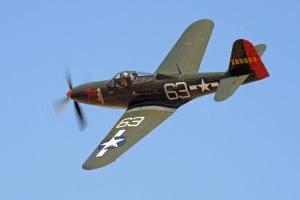 |
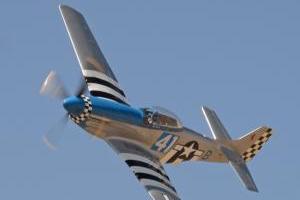 |
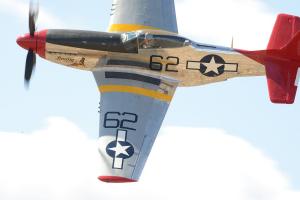 |
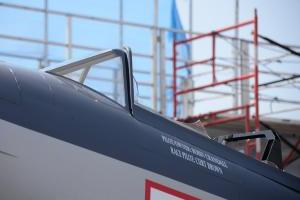 |
| #63; Pretty Polly, a Bell P-63C. The Allison V-1710 powered racer was piloted alternately by Jim “JD” Dale and Pat Nightingale. Pretty Polly paints a pretty picture out on the pylons and it’s good to be able to compare the sound of an Allison with that of the Merlin. | #41 Lady B, a P-51D Mustang, qualified at 317.901 mph and finished the week taking 5th in Sunday’s Silver Final at 320.058 mph. | #62 Bunny, is the stablemate of #63 Pretty Polly, both from the Palm Springs Air Museum. Piloting duties for the P-51D Mustang were shared between Tom Nightingale and Mark Moodie. | #71 Sawbones, a R-3350 powered Sea Fury that had intended to be Dreadnought’s main competitor, but loss of the canopy during practice kept the racer out of the competition. |
The Airshow
This year the Reno Race Committee was able to schedule the USAF Thunderbirds military jet demonstration team, who put on their usual gripping and exciting, airshow performance.
STOL Drag Racing
This STOL (Short Take-Off & Landing) event was considered as part of the Airshow this year as it previewed to become a part of the annual racing schedule. It is a rather unique event that entirely takes place in about 2,000 feet, fully in front of the grandstands and crowd. Two “bush” type airplanes pair up on the taxiway adjacent to the main runway, the flag is dropped and both quickly accelerate, become airborne and fly to a midcourse pylon where they cut power and immediately land and must come to a complete stop. This is followed by a quick “U” turn and then each accelerates for another takeoff, but in the opposite direction. Again, passing the midcourse pylon they cut power and “slip” in for a quick landing. The event is timed and the “winners” face-off in follow-on elimination drags. It’s very quick, demonstrates amazing airmanship and the STOL capabilities of these “bush” configured airplanes. This year there were 18 entries and the event proved to be quite popular. It should be a really exciting addition to the racing program for 2020.
The airplanes are largely Kitfoxes, Highlanders, Carbon Cubs, Cessnas and Wilgas. Modified engines are allowed and range from 100 horsepower Rotax to 680 horsepower Pratt & Whitney PT6As. Exciting!
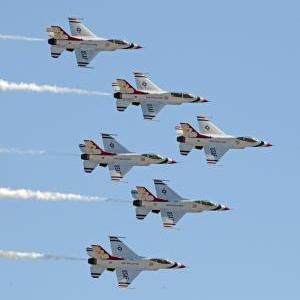 |
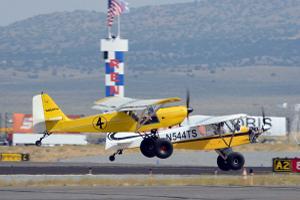 |
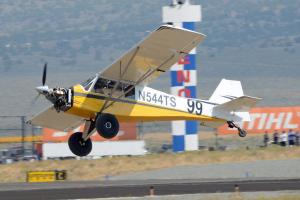 |
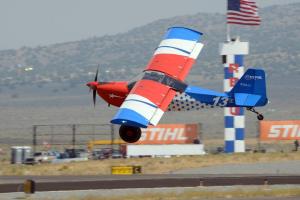 |
| The six F-16s of the USAF THUNDEREBIRDS in close formation. | Bryan Bowen, #4 in a Kitfox, and Kyle Moses, #99 in a Rans S-7S, making first takeoff in their drag race. | Kyle Moses, #99 in a Rans S-7S, coming in for his second landing. | STOL #13 |
The Other Racing Classes
While this Aircraft Engine Historical Society article focuses on the big racers in the Unlimited Class at Reno, there is a lot of other racing going on as well. The Jet Class, Sports Class, T-6 Class, Biplanes and Formula One classes all have a full race schedule, with racing starting at eight in the morning and continuing until about five in the afternoon. In total, there were 60 heat races during the four days of racing, with 115 qualifying racers, up from 108 last year. There is a LOT of racing going on at Reno! A brief description of the classes and some of the aircraft follows.
 |
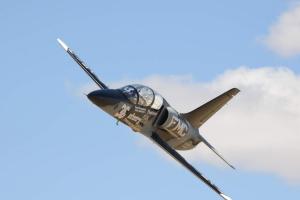 |
 |
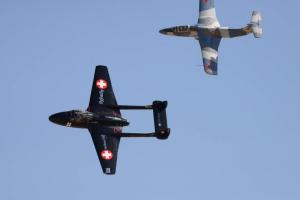 |
| This year there were 14 Jet Class racers. This included nine L-39s, three L-29s a DeHavilland Vampire and a Jet Provost. Qualifying speeds ranged from 370.178 to 513.756 mph, a little faster than last year. This photo shows L-39 #84 Tumbling Goose, who qualified as tenth fastest at 437.277 mph, rounding a pylon. | Below, during a practice race on Wednesday, #38 cut inside of Pylon #8, and directly over the photographers! Got a good close and personal shot! | The Jets were the fastest class in the 56th STIHL National Championship Air Races. Shown here is Pete Zaccagnino in Just Lucky, an L-29 Delfin passing Pylon #2 during Sunday’s Gold Final, which he won with a speed of 495.106 mph | The DeHavilland Vampire Dark Shadow posted the fastest qualifying speed at 513.756 mph, but was a DNS for the final.Just Lucky qualified second at 510.304 mph. |
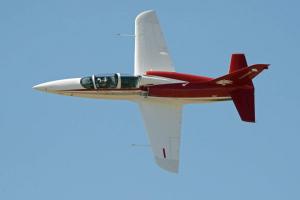 |
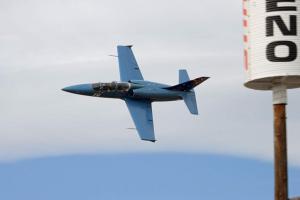 |
 |
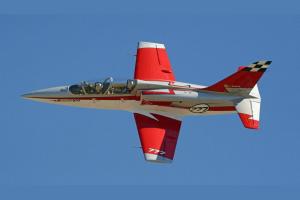 |
| #1 Athena | #19 Blue Ice | #61 Miss Independence | #777 Red Thunder |
 |
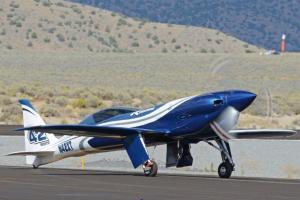 |
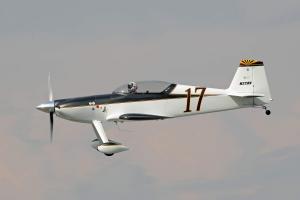 |
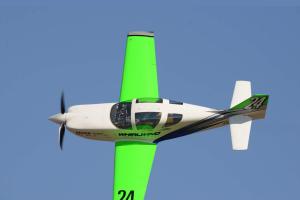 |
| Sport Class racers may be any kit or amateur built airplane, as long as their engines are under 1,000 cubic inches displacement, but otherwise unlimited as they allow turbosuperchargers, ADI, and even nitrous oxide injection. This year’s qualifying speeds ranged from a low of 204.878 to Andrew Findlay’s 398.346 mph in his STIHL sponsored Lancair Super Legacy. For the second year in a row Andrew won the Gold Final in the turbosupercharged One Moment; his speed this year was 390.744 mph. | Kevin Eldredge in the turbosupercharged #42 Relentless came in second at 358.740 mph. | #17 Calamity Jane | #24 Super Glasair III |
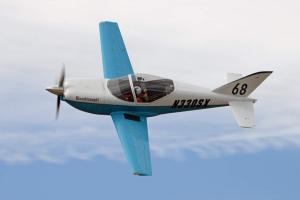 |
 |
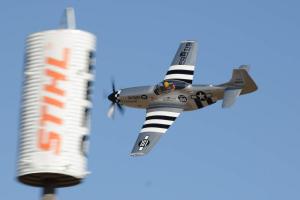 |
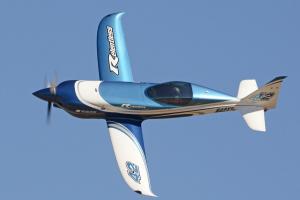 |
| #68 Wasabinought | #130 and #744 | #151 Clas Thunder | #42 Relentless |
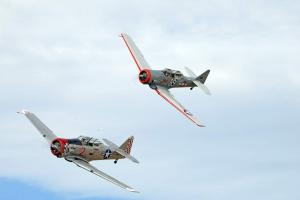 |
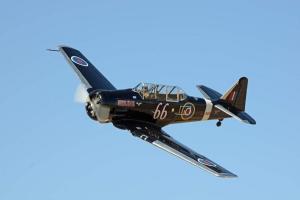 |
 |
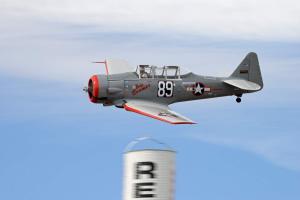 |
| Qualifying speeds for the “stock” T-6 class ranged from 192.636 to 233.706 mph, 10 mph slower that 2018, with 15 T-6 racers of eight different flavors of the type, T-6, SNJ and Harvard. The racing is tight, close and noisy, as you can see in this Sunday Silver race! Michael Pfleger in #2 edged out Gene McNeely in #89 in this race with a speed of 221.523 to 221.310 mph. The Heat winner was Greg McNeely in the #90 Undecided with a speed of 223.468 mph. The Sunday Gold winner was Chris Rushing in #14 Barons Revenge at a speed of 235.081 mph. | T-6 Race #66, Gunslinger, is an AT-6A piloted by Vic McMann. He qualified in forth position at 229.422 mph, and completed the Sunday Gold in fourth place as well, with a speed of 229.714 mph. | #66 and #88 | #89 Baby Boomer |
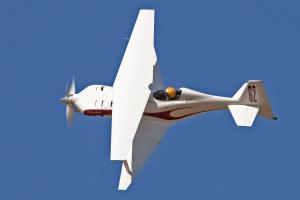 |
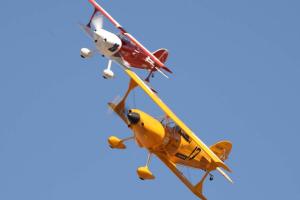 |
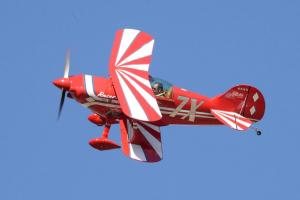 |
| Biplane Class winner was #62 Phantom, a modified Mong Sport, again piloted by Andrew Buehler. He qualified at 245.009 mph, ten mph faster than in 2018. Unfortunately, the Sunday Gold final had to be canceled due to high winds, so the Gold win was assigned to Buehler based on his Saturday win with a speed of 227.755 mph. Phantom is dramatically faster, by at least 35 mph, than the competing Pitts Specials, of which there were some 16 this year. | Biplane #17 Yellow Fever, a Pitts S-1S piloted by Eric Zine, in Thursday’s Silver Heat where he finished fifth with a speed of 189.123 mph. Some very close racing! | #7X |
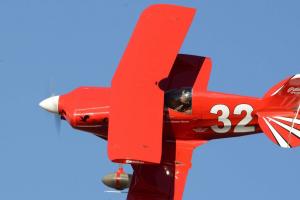 |
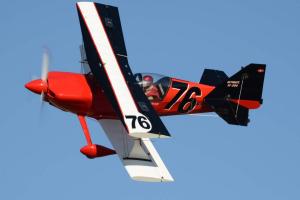 |
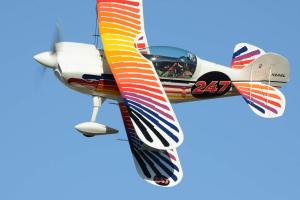 |
| #32 There Be Dragons | #76 Rudolf | #247 Slow Roll |
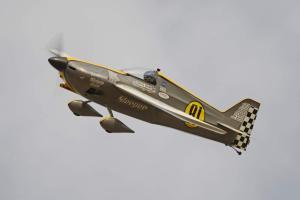 |
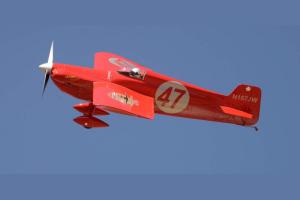 |
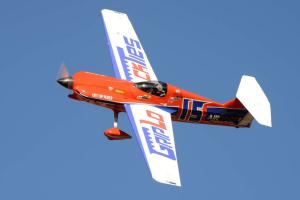 |
| Formula One racer #81 Sleeper is a Cassutt III-M piloted by Des Hart of Perth, Scotland. Des qualified at 205.180 mph and finished 2nd in his Wednesday heat race with a speed of 202.602 mph.; This photo is of Sleeper during Sunday’s Gold Final, where Hart finished as the last of the eight racers, his speed being 191.356 mph while #31 Fraed Naught won at 243.442 mph. Qualifying speeds vary widely for the 20 racers in the Formula One class, ranging from 167.006 to 249.101 mph. | #47 Mach Chicken, also a Cassutt III-M (M for Modified), showing a very different profile than #81, was piloted by Chris Weaver and won the Saturday Bronze heat with a speed of 179.464 mph. In Saturday’s Silver Final, shown below, he finished in 6th place with a speed of 173.206 mph. | #15 Last Lap Player |
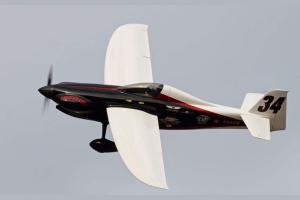 |
 |
 |
| #34 Limitless | #4 Tumbleweed | #79 No Strings Attached |
Summary
While the “heavy metal” in the Unlimited Class this year was just Dreadnaught and Miss America, there are some good rumors that Voodoo and maybe Strega will be back in 2020, which would bring some real excitement and drama to the event! So next year could be some real fun!
See you all at Reno 2020!
| Race No. | Name | Aircraft Type | Pilot | Qualifying mph |
Thursday mph |
Friday mph |
Saturday mph |
Sunday mph |
|---|---|---|---|---|---|---|---|---|
| 8 | Dreadnought | Hawker TMK20 Sea Fury/R-4360 | Sanders, Dennis | 417.868 | BYE | 420.785G1 | 418.770G1 | 403.274G1 |
| 11 | Miss America | P-51D Mustang | Hisey, Brent | 414.131 | BYE | 384.368G2 | 395.765G2 | DNF6 |
| 114 | Argonaut | Hawker Mk 11 Sea Fury/R-2800 | Smoot, Sherman | 372.497 | BYE | 365.730G3 | 362.554G3 | DNF7 |
| 924 | #924G | Hawker TMK20 Sea Fury/Centaurus | Swager, Joel | 372.341 | BYE | 364.348G4 | 360.415G4 | 348.818G23 |
| 2 | Goldfinger | F-51D Mustang | Brown, Mike | 353.661 | 335.864B1 | 325.593G5 | 334.863G5 | 300.640G34 |
| 31 | Speedball Alice | P-51D Mustang | Vance, Dan | 348.012 | 308.407B2 | 315.562S1 | 297.478G6 | 239.332G45 |
| 44 | Sparky/Blondie | P-51D Mustang | Seghetti, Brant | 342.772 | 306.857B3 | 314.701S2 | 321.344S1 | 330.231S1 |
| 0 | Wee Willy II | P-51D Mustang | Patterson, Robbie | 322.886 | 306.749B4 | 314.469S3 | 318.368S2 | 330.056S2 |
| 63 | Pretty Polly | P-63C Kingcobra | Dale, Jim “JD” | 309.364 | 276.207B7 | 293.177S62 | DNS | 296.668S52 |
| 41 | Lady B | P-51D Mustang | Pfleger, Michael | 306.336 | 305.906B5 | 300.419S4 | 316.439S3 | 307.218S3 |
| 62 | Bunny | P-51D Mustang | Nightingale, Tom | 299.6381 | 305.614B60 | 296.638S51 | 315.101S40 | 302.268S41 |
| 71 | Sawbones | Hawker FB11 Sea Fury/R-3350 | Brown, Curt | No Time | DNS | DNS | DNS | DNS |
|
M = Medallion, B = Bronze Heat Race, S = Silver Heat Race, G = Gold Heat Race, DNS = Did Not Start, DNF-# = Did Not Finish-lap out, DNQ = Did Not Qualify, DNR = Did Not Race, DQ = Disqualified, BOLD = 1st Place Heat Winners, Number following Heat letter is finishing position 0 Piloted by Mark Moodie 1 Piloted by Tom Nightingale 2 Piloted by Patrick Nightingale 3 Completed 7 of 8 laps 4 Completed 6 of 8 laps 5 Completed 5 of 8 laps 6 Completed 2 of 8 laps, DNF/Engine 7 Mayday on first lap | ||||||||
Send mail to
![]() with questions or comments about this web site.
with questions or comments about this web site.